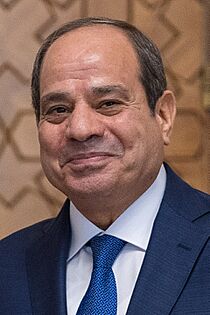President of Egypt facts for kids
Quick facts for kids President of theArab Republic of Egypt |
|
|---|---|

|
|

|
|
| Style | His/Her Excellency |
| Residence | Heliopolis Palace, Cairo, Egypt |
| Term length | Six years,
renewable once
|
| Constituting instrument | Constitution of Egypt (2014) |
| Precursor | King of Egypt |
| Formation | 18 June 1953 |
| First holder | Mohamed Naguib |
| Succession | Line of succession |
| Deputy | Vice-President of Egypt |
| Salary | LE 2,224,548 (approx. US$72,000) annually |
The President of the Arab Republic of Egypt is the main leader of Egypt. This person is the head of state, which means they represent the country. They also choose the head of government (the Prime Minister) according to Egypt's laws.
The President is also the top commander of the Egyptian Armed Forces. They lead the executive branch of the Egyptian government.
Since Egypt became a republic in 1953, six people have been president. The first was Mohamed Naguib. Then came Gamal Abdel Nasser, followed by Anwar Sadat. After him was Hosni Mubarak, and then Mohamed Morsi. The current president is Abdel Fattah el-Sisi, who started his role on June 8, 2014.
Contents
History of Egypt's Presidents
The first president of Egypt was Mohamed Naguib. He worked with Gamal Abdel Nasser to lead the Egyptian Revolution of 1952. This revolution removed King Farouk from power. It also ended British rule in Egypt.
After the revolution, King Farouk's young son, Fuad II, was briefly named king. But the real power was with Naguib and the Egyptian Revolutionary Command Council. On June 18, 1953, Egypt became a republic. Mohamed Naguib was named its first president.
Naguib resigned in November 1954 because of disagreements with younger military officers. The presidency was empty until January 1956. Then, Gamal Abdel Nasser was chosen as president by a public vote. Nasser remained president of Egypt until he passed away in September 1970. He was also president of the United Arab Republic from 1958 to 1971.
Anwar Sadat took over after Nasser. He was Nasser's vice president. Sadat was chosen by a public vote in October 1970. He served as president until he was assassinated in October 1981. Sadat won the Nobel Peace Prize in 1978. He shared it with Israeli prime minister Menachem Begin for starting peace talks between their countries.
Hosni Mubarak became president after Sadat. He was Sadat's vice president. Mubarak was elected by a public vote and stayed in office for almost 30 years.
In the Egyptian Revolution of 2011, Mubarak had to resign. This happened after many protests across the country. On February 10, 2011, Mubarak gave his powers to his vice president, Omar Suleiman. But this was only for a short time. The presidency then became officially empty. The Supreme Council of the Armed Forces, led by Field Marshal Mohamed Hussein Tantawi, took control of the government.
On June 30, 2012, Mohamed Morsi became President of Egypt. He was from the Muslim Brotherhood. Morsi won the 2012 Egyptian presidential election on June 24. He was the first president chosen only by a popular vote. However, Morsi's time as president was short. He was removed from office on July 3, 2013, after large protests against his rule.
Abdel Fattah el-Sisi was the Defense Minister under Morsi. He retired from the Egyptian Armed Forces in 2014. He then won the 2014 Egyptian presidential election. He became president on June 8, 2014. He was re-elected for a second term in the 2018 Egyptian presidential election. In April 2019, Egypt's parliament changed the presidential term from four to six years. This change also allowed President Abdel Fattah al-Sisi to run for a third term. He won the 2023 Egyptian presidential election for his third term. He started his new term in April 2024.
How Presidents Were Chosen Before 2005

Before 2005, the way Egypt chose its president was similar to how France did it. First, the Egyptian parliament (called the National Assembly) would suggest one candidate for president.
This candidate needed at least two-thirds of the votes from the Assembly to be chosen. Then, all eligible voters in the country would vote in a public election to confirm the candidate. Egypt used this system even after France stopped using it.
Changes to How Presidents Are Chosen
In 2005 and 2007, Egypt changed its laws about how presidents are elected. Here are some of the main changes:
- Citizens who can vote now choose the president directly by secret ballot.
- There must be more than one candidate for people to choose from.
- The process for choosing candidates became more fair.
- Political parties can now suggest one of their leaders to run for president.
- A special "Presidential Election Commission" was created. This group is completely independent and watches over the election process.
- Judges now supervise the voting process to make sure it is fair.
If no candidate wins more than half of the votes, the election is repeated. The two candidates with the most votes go into a second round. The person who gets the most votes in the second round becomes president.
What the President Does
Under Egypt's current laws (the 2014 Constitution), the president is the head of the country and the head of the government's executive branch. The president works with the prime minister and the cabinet to set the country's main goals. They also make sure these goals are carried out.
The president represents Egypt in other countries. They can approve international agreements. If the parliament is not meeting, the president can issue temporary laws. These laws must be approved by the parliament later. The president is also the top commander of the armed forces. They can also grant pardons and use special powers during emergencies.
How to Become President
The election for president happens within 60 days before the current president's term ends.
Who Can Be President?
To become president of Egypt, a person must meet certain requirements:
- They must be an Egyptian citizen.
- Both of their parents must be Egyptian. They cannot have citizenship from another country.
- They must have served in the military or been excused from it.
- They must be at least 40 years old.
Candidates also need support to run. They must get recommendations from 20 members of the House of Representatives. Or, they can get support from 25,000 people across 15 different areas of Egypt. At least 1,000 signatures must come from each area.
The Presidential Election Commission
This special group makes sure the presidential election is fair. It is made up of ten members. The chief judge of the Supreme Constitutional Court leads the commission. Other members are senior judges and five independent public figures.
This commission handles everything about the election. This includes accepting candidates, announcing who is running, supervising voting, counting votes, and announcing the results. Their decisions are final and cannot be appealed.
Taking the Oath of Office
Before starting their job, the president must take an oath. They promise to protect the country's system, respect the laws, care for the people, and keep the country independent.
How Long a President Serves
A president in Egypt serves for a term of six years. They can be re-elected only once.
In February 2019, Egypt's parliament voted to change the constitution. This change extended the presidential term from four years to six years. It also allowed the current president, Abdel Fattah el-Sisi, to extend his current term to six years. He was also allowed to serve a third and final term. These changes were approved by a public vote in 2019.
While in office, the president cannot be an official member of a political party. If a new president is chosen before the current president's term ends, the current president stays in office until their term is over.
What Happens if a President Can't Serve?
If a president is temporarily unable to do their job, they can give their powers to the vice president or the prime minister. However, the person taking over has limited power. They cannot dissolve parliament, suggest changes to the constitution, or remove the cabinet.
If the president's office becomes permanently empty, the Speaker of the People's Assembly takes over temporarily. If parliament is dissolved at that time, the President of the Supreme Constitutional Court takes over. Neither of these people can run for president themselves. They also have limited powers, similar to a temporary vice president or prime minister.
When the office becomes empty, parliament announces it. A new president must then be chosen within 60 days.
Historically, vice presidents have often taken over when the presidency became empty. Both Anwar Sadat and Hosni Mubarak were vice presidents when they became president. However, Mubarak did not appoint a vice president until 2011, during large protests. He appointed Omar Suleiman at that time.
Resigning from Office
A president can resign by giving their resignation to the People's Assembly.
Gamal Abdel Nasser resigned after Egypt's defeat in the Six-Day War, but he later took it back after public protests. President Mubarak also resigned on February 11, 2011, during large protests against his rule.
Presidential Homes
The president of Egypt uses eight official homes, plus other guest houses. The main official home and office is Heliopolis Palace in Cairo. Other presidential palaces include:
- Abdeen Palace, in Old Cairo;
- Koubbeh Palace, in Cairo;
- Ras Al-Teen Palace, in Alexandria;
- Montaza Palace, in Alexandria;
- Al-Tahra Palace, in Cairo;
- Al-Oroba Palace, in Cairo.
List of Presidents
See also
 In Spanish: Anexo:Presidentes de Egipto para niños
In Spanish: Anexo:Presidentes de Egipto para niños
- List of heads of state of Egypt, for a full list of Egypt's leaders since 1805
- Lists of rulers of Egypt


